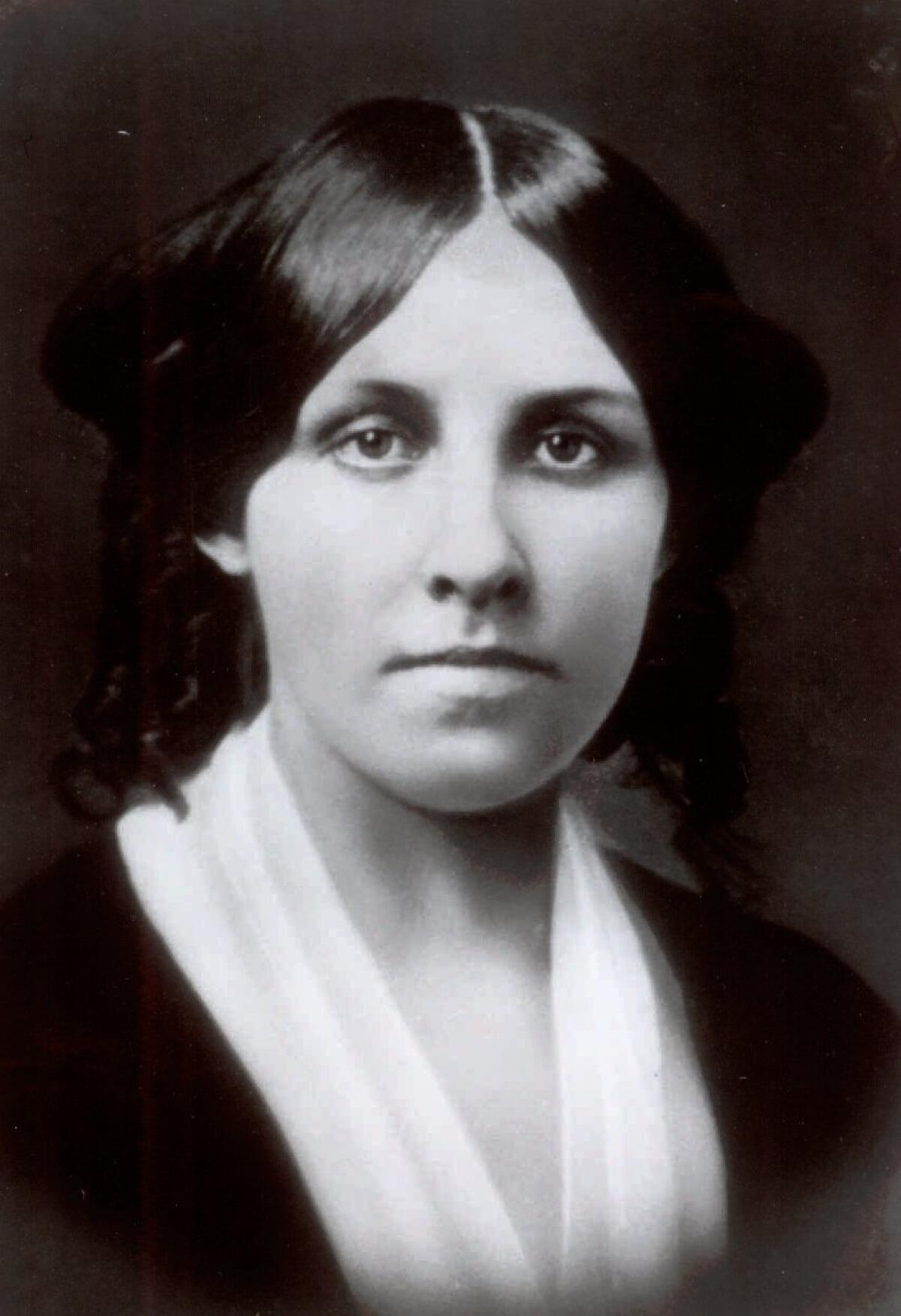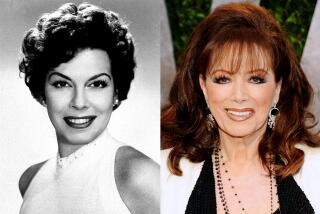Column: ‘Little Women’ is great but where is the Louisa May Alcott biopic?

- Share via
At an early screening for “Little Women,” director Greta Gerwig introduced her splendid new film by saying that when she was a child, she idolized the character Jo March, and when she was grown, she idolized Jo’s creator, Louisa May Alcott.
The film, which opened last week to critical raves and robust box office, certainly bears this out. It takes the famously semiautobiographical tale a few steps further into memoir by granting Jo a few of Alcott’s own tics (including the habit of switching hands when one became too tired while writing) and a fully realized career similar to Alcott’s own. And as the audience Gerwig was addressing made instantly clear, she was not alone in her two-pronged adoration of work and author.
For many who came of age pre-“Harry Potter” or “Hunger Games,” Jo March and, by extension, Alcott were lode stars. Classic literature abounds with recognizably human boys and young men overcoming adversity and pursuing adventure, but for those seeking heroines, there was only Alcott and mostly “Little Women.” Jo, with her wild imagination, famously bad temper and desire to be a soldier rather than a knitter of socks, resonated with any young woman who longed to follow a path marked “men only.” Legions of female authors still cite “Little Women” as an enduring influence.
Published in 1868, “Little Women,” which ends with the return from the Civil War of Mr. March, sold out its 2,000-book initial run in days; when 6,000 more were printed, they sold out too. Alcott quickly wrote “Good Wives” (what is now the second part of “Little Women”) and by the end of 1869, the combined book had sold nearly 40,000 copies, a 19th century blockbuster.
With its success and almost immediate demand for sequels — “Little Men” (1871) and “Jo’s Boys” (1886) — and other girl-centric stories, including “An Old-Fashioned Girl” (1869), “Eight Cousins” (1875) and “Rose in Bloom” (1875), Alcott created a franchise and became a literary celebrity.
Which begs the obvious question: How on earth did Emily Dickinson get a television series before Louisa May Alcott did? I cannot be the only one who longs to see Frances McDormand as the adult Alcott guiding us through a biographical limited series on HBO or Hulu; can someone who knows her call and see if she’s interested?
Apple TV’s “Dickinson,” which premiered in November on Apple TV+, has been praised (and in some circles criticized) for its exuberant and consciously modern reimagining of a life too long defined by solitary eccentricity. As played by Hailee Steinfield, the young poet is, basically, Jo March transplanted to Amherst. When not writing, young Emily puts on plays, turns down a proposal from her best friend, speaks out against slavery, confronts Henry David Thoreau and openly refuses to accept that women are somehow intrinsically less than men.
All of which Dickinson may or may not have done — her biographical material is, alas, scanty — but Alcott most certainly actually did.
Yet when a young Alcott makes an appearance in “Dickinson,” she is portrayed, by a hilarious (and inexplicably blond) Zosia Mamet, as a fast-talking, hard-headed commercial writer. She urges Emily to abandon poetry for more lucrative markets as they go for a predinner run. “I run,” Alcott says at one point. “That is an actual fact of my life.”
It is an actual fact of her life. Although there is no account of Alcott ever meeting Dickinson, who was a contemporary, Alcott was definitely the first notable American woman who was also a runner. And apparently, even when burdened by skirts, petticoats, hairpins and highly nondynamic footwear, she was pretty fast.
Alcott also was an outspoken feminist, an abolitionist turned civil rights activist, a vegetarian, a teetotaler and an ardent supporter of Amelia Bloomer’s work to create nonrestrictive female fashion (the Bloomer suit was the closest thing those poor women had to leggings), as was her mother, Abigail. Her father, Bronson, was a Transcendentalist educator and lecturer who could not make or hold onto money. Alcott worked to support her family most of her life, as a writer but also as a teacher, a seamstress, a governess, a companion and, during one particularly difficult time, a house servant.
In 1863, she briefly served as a nurse in a Union hospital, where she contracted typhoid. She almost died but still managed to produce “Hospital Sketches,” one of the first accounts of Civil War hospitals and an early model for experiential journalism.
She lived much of her adult life with a chronic debilitating illness that historians once believed was caused by mercury poisoning (mercury was used to treat typhoid) and now believe was an autoimmune disease, possibly lupus. Alcott often despaired of ever achieving financial security and once, according to her own writing, considered suicide.
So yes, she absolutely wrote for the money. “Little Women” exists because Alcott’s publisher asked specifically for a story for girls because they were in demand at the time. After months of complaining that she didn’t want to write children’s fiction, never understood girls and preferred boys, she spent six weeks spinning a tale based, loosely and romantically, on her own life.
“I had lots of troubles so I wrote jolly stories,” she explained in her later years.
While Dickinson’s life was a mystery, Alcott’s was a narrative masterpiece played out within the political hotbed of 19th century Concord, Mass., with a supporting cast to make Ken Burns weep.
She hung out with all the best Transcendentalists — babysitting for Ralph Waldo Emerson, taking woodland walks with Henry David Thoreau, shocking Margaret Fuller with her boisterous nature — and some of the most dedicated abolitionists (her uncle Samuel Joseph May cofounded the New England Anti-Slavery Society and the Alcotts sheltered at least one fugitive on the Underground Railroad).
Speaking of which, let us pause for a moment to offer thanks that Harriet Tubman, one of the greatest Americans of all time, finally got a movie made about her following the unfortunate cancellation of “Underground.” All in all, it has been a pretty decent year for 19th century women.
Which is why the time is so right for the Louisa May Alcott story. One of the reasons “Little Women” remains so popular — it has been remade on film twice as many times as “A Star Is Born” — is its semiautobiographical nature. But the emphasis should be on “semi.”
“Everyone wants ‘Little Women’ to be about the Alcotts,” says Eve LaPlante, author of “Marmee and Louisa: The Untold Story of Louisa May Alcott and Her Mother.” “Even Louisa wanted it to be about the Alcotts. But it wasn’t. It glosses over too much, which may be why we love it so much. She had a very hard life; there was a lot of pain.”
LaPlante is a distant cousin of Alcott and a writer of historical biographies. While helping to clean out a family attic, she discovered a trunk full of correspondence and journals that offered a different perspective on the Alcott family. “Marmee and Louisa” became a bestseller in 2014; Laura Dern recently told Vanity Fair that it was a major influence in how she portrayed Marmee in Gerwig’s film.
Reading the book and talking with LaPlante only confirms the notion that while Alcott’s work is full of people, incidents, themes and beliefs drawn from her own life — Amelia Bloomer, for example, gets a shoutout in “Eight Cousins,” while the Transcendentalist beliefs in a charitable life, the power of prayer, a healthy diet and an appreciation of nature infuse all of her works — none come close to capturing the complexity of the author herself.
“The family lived mostly in abject poverty until Louisa became successful,” says LaPlante. “The children were often hungry, and cold; they moved around a lot, living in houses that were usually paid for by someone else. Abigail married Bronson because he was so different from the men her parents wanted her to marry. Essentially he was a hippie.”
Indeed, when Louisa was 10, Bronson cofounded a Utopian community called Fruitlands, where no meat, animal products or root vegetables could be eaten; no artificial light could be used; no water could be heated; and no animal labor, excepting that of his wife and children, could be employed.
Abigail could live with the fact that Bronson’s revolutionary ideas about education, which included extending it to black children, repeatedly cost him jobs. But after six months of working nonstop while the menfolk philosophized and wandered nude beneath the sun, she pulled the plug on Fruitlands. (In “Transcendentalist Wild Oats,” Alcott proves she could write very sharp satire when she wished.)
“Marmee and Louisa” has been optioned, LaPlante says, so there’s hope. Meanwhile, there’s Gerwig’s “Little Women,” which is lovely and amazing, and perhaps Mamet will have a repeat performance on “Dickinson”; even a blond, New York-ified version of Alcott is better than nothing.
Especially when she runs.
More to Read
The biggest entertainment stories
Get our big stories about Hollywood, film, television, music, arts, culture and more right in your inbox as soon as they publish.
You may occasionally receive promotional content from the Los Angeles Times.










